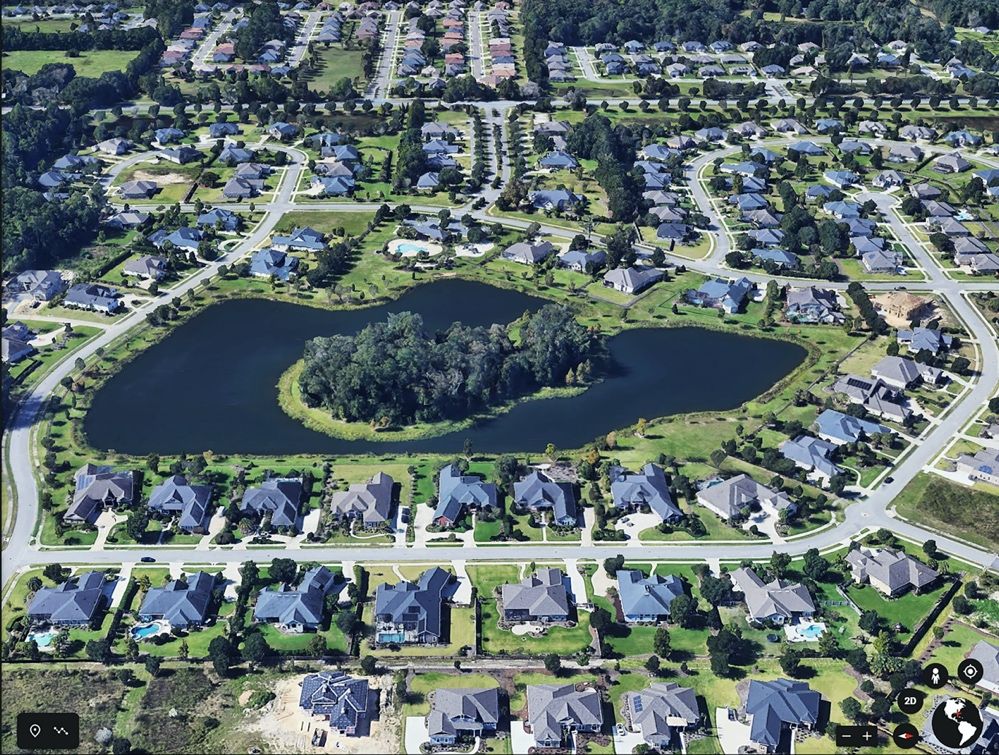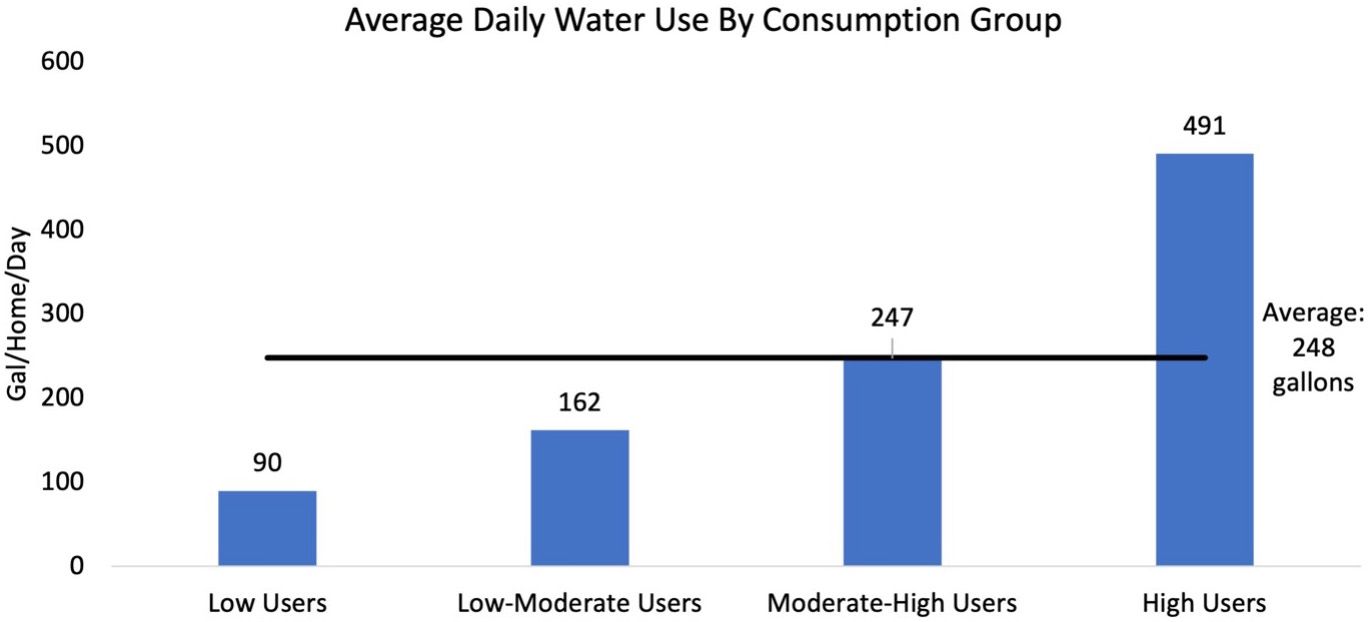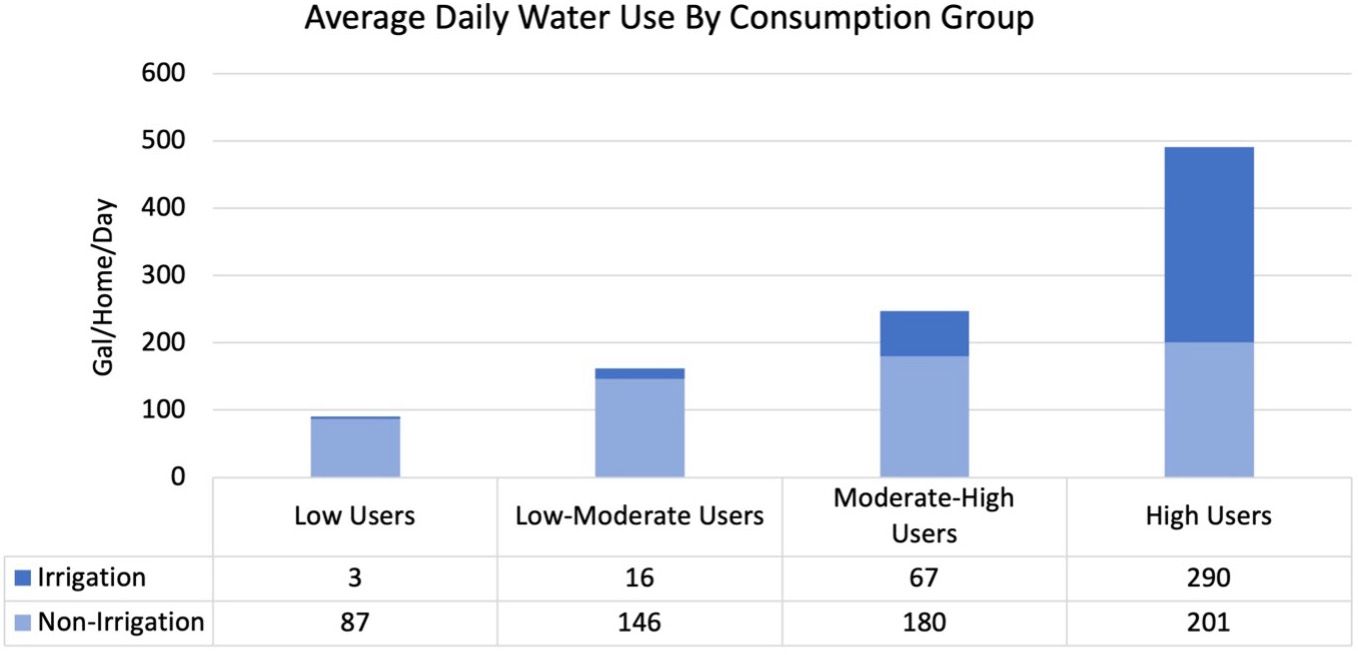Introduction
The goal of this fact sheet is to provide current, basic information about residential water use in Osceola County, Florida.
In this fact sheet, you will learn:
- Basics about water consumption for single-family, detached homes in Osceola County, Florida (Figure 1)
- Information about the highest water users and the need to target them (Figure 2)
- The impact of irrigation on water consumption

Credit: Esri, HERE, Garmin, FAO, NOAA, OpenStreetMap contributors, and the GIS User Community

Credit: UF/IFAS H2OSAV
The information in this series should be helpful for everyone, including water utility conservation staff, UF/IFAS Extension agents, and Florida homeowners, in their efforts to reduce water consumption. For an overview of the information in this fact sheet, see the infographic at the end of this publication.
Background
Florida’s water use has been steadily increasing during the last 50 years (United States Geological Survey n.d.). Water use is expected to continue increasing during the next 50 years as well. With the current trend, development-related water demand is expected to more than double in central Florida by 2070, compared to 2010 (UF Geoplan Center 2016). Water conservation efforts will have significant social, economic, and environmental impacts (Borisova 2017). To best support these conservation efforts, it is important to have a deeper understanding of residential water use.
H2OSAV (Water Savings, Analytics & Verification) is a UF/IFAS Extension program working to help measurably save Florida water. We archive multiyear datasets developed for individual water utility territories, and merge the following:
- Metered household water use data
- Conservation program data
- Property appraiser data
Enrichment and analysis of metered water data provides two valuable functions. First, H2OSAV helps find important patterns in water use. Second, it allows us to evaluate the success of ongoing water conservation programs. These patterns can help support policies designed to reduce excessive water use. They also give us the ability to provide key insights that assist in targeting homes with high water use.
As a UF/IFAS Extension program, H2OSAV is sharing these insights through a series of EDIS publications. This fact sheet focuses on single-family, detached (SFD) homes located in Osceola County, Florida.
Methods
This case study is based on metered household water consumption collected from utility providers for homes in Osceola County, Florida. Data comes from calendar years 2015 through 2020.
This analysis includes occupied, single-family, detached homes that meet the following criteria:
- Located in Osceola County, Florida
- Designated as a single dwelling unit (“single-family”) on its own lot, without physical attachment to other homes (“detached”)
- “Typical size”
- No more than 6,000 square feet of conditioned living space
- No more than 6 bedrooms
- No more than 6 bathrooms
- Lot size no more than 2 acres
- Occupied during the analysis year
- 9 months or more of non-zero indoor water use
- Monthly records with water use equal to zero were removed
Homes that did not meet these criteria were not used in the analysis. After screening, this study included 86,770 SFD homes. This represents 77.6% of the SFD homes in Osceola County.
Average Total Daily Water Use
Average daily water use was calculated for each household, each calendar year. It was calculated by taking the total monthly water use and dividing it by the total number of days in each monthly billing cycle.
Consumption Groups
SFD homes were divided into four equal quartile groups based on their average daily water use in 2020.
Irrigation vs. Non-Irrigation
For this study in Osceola County, there were 54,137 single-family, detached homes with only one water meter (single-meter) and 32,633 homes with two separate water meters (dual-meter). For dual-meter homes, one meter is used solely for “irrigation,” specifically servicing an in-ground irrigation system, and one meter is used for all other “non-irrigation” water uses. While “non-irrigation” primarily includes indoor uses such as plumbing (shower, laundry, etc.), it may also include pools, car washing, and other outdoor purposes.
Monthly consumption values for single-meter properties were broken down to estimate “irrigation” and “non-irrigation” water use. Single-meter properties do not differentiate between potable water used for irrigation and potable water used for indoor use. Therefore, the average amount of water used indoors by dual-meter properties was used as an estimate of indoor use for single-meter homes. Because water use varies by month and year, the average indoor water use for dual-meter properties was calculated in each month of each year. Irrigation use was then calculated for each single-meter home as the difference between its monthly total water use and estimated indoor use, for each month of each year.
What is the average home like in Osceola County?

Credit: Maxar Technologies, U.S. Geological Survey, Google
Based on 2020 data, the average SFD home in Osceola County:
- Was built in 2001,
- Has 3.5 bedrooms,
- Has 2.4 baths,
- Has 1,952 square feet of living space,
- Has a 6,120-square-foot yard, and
- Is on a 0.19-acre lot.
What is the average daily water use?
In 2020, SFD homes in Osceola County used an average of 248 gallons of water per day. That amount is equal to 1,878 standard (16.9 fl oz) bottles of water. This would be more than a pallet worth of water bottles daily.

Credit: UF/IFAS
As shown in Figure 5, SFD household water consumption has been fairly steady over the last six years, ranging from 243 to 253 gallons per day.

Credit: UF/IFAS H2OSAV
How much water do the highest-consuming homes use?
Some homes use a lot more water than others. We wanted to look at the differences between these homes to understand why. We divided homes into four groups (quartiles) based on the amount of water used in 2020. They were grouped as follows:
- The top 25% of homes were labeled as “High Users.”
- The next 25% were labeled “Moderate–High Users.”
- The next 25% were labeled “Low–Moderate Users.”
- The bottom 25% were labeled “Low Users.”
The graph below (Figure 6) compares the average daily water use in these four user groups. We can see that High Users in Osceola County use 491 gallons of water per day. That is almost as much water as the other three groups combined and almost twice the average for all homes in the county.

Credit: UF/IFAS H2OSAV
As mentioned before, the average daily water use for the study group is equal to 1,878 bottles worth of water. In comparison, the highest users use the equivalent of 3,719 bottles worth of water every day. Figure 7 shows that this is more than 2.5 full pallets worth of water daily.

Credit: UF/IFAS H2OSAV
How are these homes using their water?
Most newer homes have in-ground irrigation systems, which can use a large amount of water. For example, consider a home on a ¼-acre lot with their in-ground irrigation system set to deliver ½ inch of water per cycle. This home would use more than 2,000 gallons of water each time the lawn was watered.
Figure 8 highlights the impact of irrigation on overall water use. The graph shows water use divided between irrigation and non-irrigation. Irrigation means watering lawns using an in-ground irrigation system. Non-irrigation refers to water used for all other purposes (shower, laundry, pool, garden hose, etc.).
As Figure 8 shows, the dramatically higher water use of the High Users group is mainly due to irrigation. The High Users are using almost 60% of their water irrigating their yards.

Credit: UF/IFAS H2OSAV
The difference in non-irrigation water use between the High Users and Moderate–High users is only 21 gallons per day. For irrigation, however, the High Users are using 223 gallons more than the Moderate–High Users every day. Factors such as pools and larger homes, as seen in Table 1, could only contribute to that comparatively small increase in non-irrigation water use. Reducing irrigation would provide the greatest opportunity for the High Users to save water.
Discussion: How does this affect our future?
Florida has the third largest population in the United States (United States Census Bureau n.d.). That population is expected to grow by an additional 15 million people by the year 2070 (UF GeoPlan 2016). In Osceola County, an additional 30,047 SFD homes were built between 2010 and 2020. This means that 26.8% of SFD homes currently in the county were built during the last decade. We need to prepare for this increase in homes and population, because they will continue to have an impact on our water resources.
It is understandable that subdivisions and individual homes use different amounts of water. It is critical, however, to recognize that some homes in this area (“High Users”) are using over twice the average amount of water. Understanding the highest water users makes it possible to target water conservation efforts. This is practical, because it is most effective to target those with the highest water use (Taylor, Jones, and Kipp 2014). Specifically, given that irrigation is a large portion of the High Users’ overall water use, focusing conservation efforts on reducing irrigation in high-use homes is the best opportunity for water conservation.
This fact sheet has provided basic information about water consumption in Osceola County, stated the importance of knowing the High Users, and raised awareness of the impact of irrigation. This information can improve conservation efforts and inform future development practices. The water use data can be used to benchmark success and to evaluate the impact of new developments. In addition, homeowners can use the information in this document to understand their own water use. We encourage homeowners to follow best management practices to reduce their water use.
UF/IFAS suggestions for saving water include the following:
- Water your landscape on an "as-needed" basis.
- Check your irrigation timer to make sure you are following local irrigation restrictions.
- Look for any blocked, broken, or leaking spray heads.
- Make sure that you have a working rain shutoff device.
- Set your sprinkler system to not deliver more than ½ inch or ¾ inch of water.
References
Borisova, T., L. A. Warner, J. Searcy, A. K. Chaudhary, and M. Dukes. 2017. Estimating Benefits of Residential Outdoor Water Conservation: A Step-by-Step Guide. FE1009. Gainesville: University of Florida Institute of Food and Agricultural Sciences. https://edis.ifas.ufl.edu/fe1009
Boyer, M., and M. Dukes. 2018. Estimated Water Savings Potential Of Florida-Friendly Landscaping Activities. AE515. Gainesville: University of Florida Institute of Food and Agricultural Sciences. https://edis.ifas.ufl.edu/publication/ae515
Office of Economic and Demographic Research. 2018. “Florida: An Economic Overview.” Accessed August 9, 2019. http://edr.state.fl.us/Content/presentations/economic/FlEconomicOverview_12-26-18.pdf
Olmstead, T. R., and M. Dukes. 2017. Frequency of Residential Irrigation Maintenance Problems. AE472. Gainesville: University of Florida Institute of Food and Agricultural Sciences. https://edis.ifas.ufl.edu/ae472
Taylor, N. W., P. H. Jones, and M. Jennison Kipp. 2014. “Targeting Utility Customers to Improve Energy Savings from Conservation and Efficiency Programs.” Applied Energy 115:25–36. https://doi.org/10.1016/j.apenergy.2013.10.012
Trenholm, L. E., J. B. Unruh, and J. L. Cisar. 2013. Watering Your Florida Lawn. ENH9. Gainesville: University of Florida Institute of Food and Agricultural Sciences. https://edis.ifas.ufl.edu/publication/LH025
United States Census Bureau. n.d. “U.S. Census Bureau QuickFacts: Alachua County, Florida.” Accessed January 28, 2022. https://www.census.gov/quickfacts/alachuacountyflorida
United States Geological Survey. n.d. Historical Water-Use in Florida. Accessed April 26, 2021. https://www.usgs.gov/centers/car-fl-water/science/historical-water-use-florida?qt-science_center_objects=0#qt-science_center_objects
University of Florida GeoPlan Center (UF GeoPlan Center). 2016. Water 2070 Mapping Florida's Future – Alternative Patterns of Water Use in 2070. http://1000friendsofflorida.org/water2070/wp-content/uploads/2016/11/water2070technicalreportfinal-text-TOC.pdf

Credit: Credit: UF/IFAS H2OSAV
Table 1. Home characteristics by consumption group.